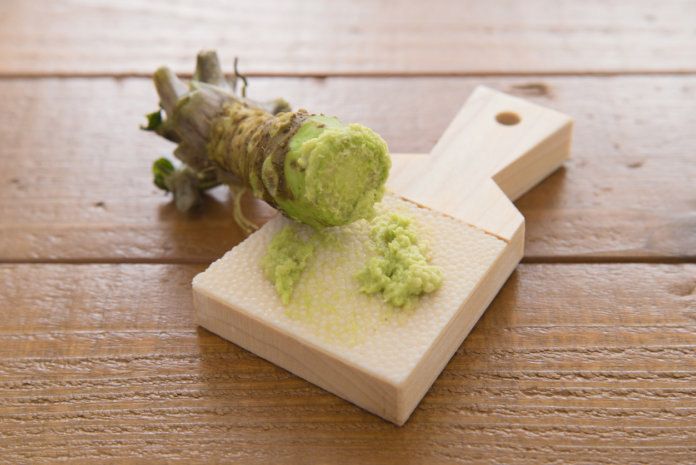When you think of sushi, you can often associate it with wasabi. Wasabi is often used as a side mixed with soy sauce to balance out the flavors of fresh fish. It is often linked with a “spicy flavor.” This is how we in America perceive wasabi. But for most Westerners, what we know as wasabi isn’t “real” wasabi at all. So what is real wasabi? And what is that green paste we eat in America if it’s not actual wasabi? And here’s the more important question. Is either kind of wasabi good or bad for you? We know you’re curious about the health benefits of wasabi. So we explored what wasabi is and isn’t, and how you can better incorporate it into your diet.
“Real” wasabi vs. “fake” wasabi
It comes as a surprise to many Americans that most wasabi served here is fake wasabi.
Real wasabi, aka Japanese horseradish, is a root vegetable. It’s one of the hardest commercial plants to grow. And it grows best in Japan. In the United States, there are only a few true wasabi farmers. Most sushi restaurants use a mixture of horseradish paste, mustard and green food dye. That’s the condiment you call wasabi.
Horseradish and wasabi come from similar plants, so the taste is similar. But it’s not the same.
You prepare real wasabi by removing the leaves and grinding the stem down into a light green paste. One of the key differences between real and fake wasabi is the level of heat. Real wasabi’s spicy heat lasts only a couple of minutes. The familiar horseradish substitute gives heat that lasts much longer. Real wasabi tastes cleaner, smoother and more “plant-like” than its substitute.
Unfortunately, real wasabi is hard to find in stores and restaurants because it’s so rare. Needless to say, it’s rarity makes it expensive as well. But it’s not impossible to find. You can get it in some Japanese restaurants. They’ll be sure to label it as the real deal.
What are the health benefits of wasabi?
Real wasabi has certain health benefits. One surprising benefit of wasabi is its ability to treat food poisoning. Wasabi contains a component called allylisothiocyanate (AIT). Studies suggest that AIT slows down food poisoning and fungi in the body. Real wasabi also is a host to a variety of vitamins, including A, B1, B2, B3, B6, C, and folate. It also contains a high level of the antioxidant isothiocyanates. It has cancer-fighting properties, and it’s also an anti-parasite, especially in seafood.
Fake wasabi contains slight nutritional value. There’s a minimal amount of iron in it. It also holds a small amount of potassium.
Is wasabi good for gut health?
Although real wasabi does have some health benefits, its full effects on the gut aren’t clear. That’s because testing in humans hasn’t been extensive enough so far. In a 2017 study, researchers infected gerbils with Heliobacter pylori. This is a bacteria strain that causes stomach issues and ulcers. The study focused on the effects of eating wasabi leaves and the component AIT. It found that the wasabi reduced stomach lesions and other effects of H. pylori in the gerbils.
Is wasabi unhealthy in any way?
The ersatz wasabi we eat in the United States is high in sodium. Those who maintain a low-sodium diet should avoid limit wasabi substitute. Most of the time, it contains soy as well. So those with a soy allergy should also steer clear.
If you have the real stuff, it can have some bad side effects.
What are the negative side effects of real wasabi?
Real wasabi does have plenty of health benefits. But it also comes with a few potential negative side effects:
- It can exacerbate gastritis symptoms. AIT, while beneficial in some ways, can irritate your stomach lining.
- As with any new food that you introduce into your diet, wasabi may cause an allergic reaction. You should consult with your doctor before adding it to your diet.
- It contains hepatotoxin. If eaten in large quantities, this can cause liver damage.
- Those with stomach issues including gastiritis, stomach ulcers, etc., should avoid wasabi. Its spicy, pungent components can irritate the stomach and cause acid reflux.
What are some ways to incorporate wasabi in cooking?
Real wasabi is wonderful as an occasional flavor enhancer to many dishes. It’s not too difficult to incorporate into your diet if you choose to have it. But because it’s so expensive and rare, you’ll want to save it for special occasions. You can use it as side mixed with soy sauce to eat with your sushi or sashimi. In the traditional Japanese manner, place the wasabi on top of the fish. Dip the fish into the soy sauce and eat it in one bite.
Whether you choose the real or fake stuff, we recommend eating wasabi in moderation.




